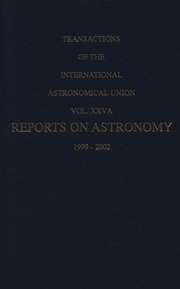No CrossRef data available.
Article contents
Commission 26: Double and Multiple Stars
Published online by Cambridge University Press: 25 April 2016
Extract
In the recent years new techniques are expanding visual binary star astronomy into previously inaccessible regimes of angular resolution and accuracy of measurements regarding the astrometric and astrophysical parameters of their components. New techniques and algorithms are providing enhanced sensitivity to low mass companions and the determination of photometric properties of the components of close visual binaries. The potential now exists for significantly narrowing, if not eliminating entirely, the historic gap separating spectroscopic from visual binaries. Advances in closely related fields as in precision radial velocity measurement and enhanced accuracy of parallax determination from ground and space based observatories will place demands upon double star astronomy that have been absent for half a century. Today double and multiple star astronomy is perhaps closer to fulfilling its true potential than it has ever been, entering a fundamentally important area of modern astrophysics.
- Type
- Research Article
- Information
- Copyright
- Copyright © Kluwer 1988


